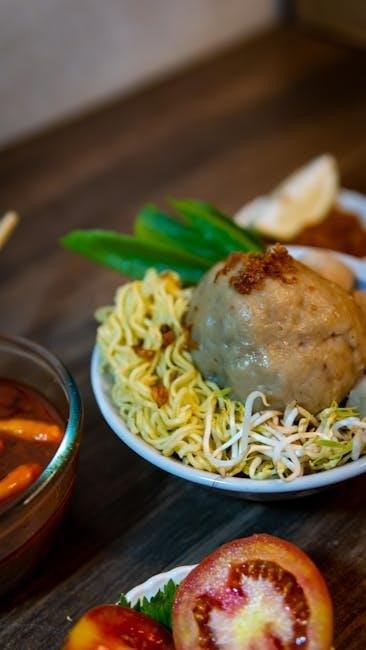
manual for rice cooker
A rice cooker is an essential kitchen appliance designed to simplify cooking rice perfectly every time․ It offers versatility, ease of use, and consistent results, making it a valuable addition to any home․
What is a Rice Cooker?
A rice cooker is a versatile kitchen appliance designed to automate the process of cooking rice․ It uses a thermostat to monitor temperature, ensuring rice is cooked evenly and preventing overcooking․ The cooker switches to a “keep warm” mode once the rice is done, maintaining the perfect serving temperature․ This appliance is simple to use, requiring only rice and water, and offers consistent results․ Its design makes it ideal for both novice and experienced cooks, providing a hassle-free way to prepare rice and other dishes like grains, soups, and one-pot meals․
Benefits of Using a Rice Cooker
Using a rice cooker offers numerous benefits, including ease of use, consistent results, and hands-off operation․ It ensures perfectly cooked rice every time without constant monitoring․ The appliance is versatile, allowing you to prepare not just rice but also grains, soups, and one-pot meals․ It saves time and reduces the risk of overcooking, making it ideal for busy households․ Additionally, rice cookers keep food warm for extended periods, ensuring your meal stays ready whenever you are․ This makes it a practical and efficient addition to any kitchen, simplifying meal preparation and enhancing cooking convenience․
Understanding Your Rice Cooker
A rice cooker is a versatile appliance with a heating element, thermostat, and cooking pot․ It automatically detects when rice is cooked, switching to warm mode for convenience․
Parts and Accessories
A rice cooker typically includes a main unit, inner pot, lid, and heating element․ Accessories like a measuring cup, rice paddle, and steam tray are often included․ The inner pot is non-stick for easy cleaning, while the lid ensures even steam distribution․ Some models come with additional features like fuzzy logic technology or delay start․ Understanding these components helps in using the cooker effectively․ Accessories vary by model but generally enhance functionality and convenience for users․
Settings and Features
Modern rice cookers offer a variety of settings to suit different needs․ Basic models include simple cook and warm functions, while advanced ones feature fuzzy logic technology for precise temperature control․ Delay start allows scheduling, and specialized settings cater to white, brown, or sticky rice․ Some cookers include steam trays for vegetables and options for pressure cooking․ Additional features like timers, keep-warm modes, and non-stick inner pots enhance usability․ These settings and features make rice cookers versatile and convenient for preparing a wide range of dishes beyond just rice․

Setting Up Your Rice Cooker
Unpack and clean the cooker before first use․ Place it on a stable, heat-resistant surface․ Plug it in and familiarize yourself with the controls․ Ensure it’s away from flammable materials and children for safe operation․
Unpacking and Initial Preparation
Start by carefully unpacking your rice cooker and inspecting all components․ Wash the inner pot, lid, and accessories with mild soap and warm water․ Dry thoroughly before use․ Ensure all parts are included and undamaged․ Place the cooker on a stable, heat-resistant surface, away from children and flammable materials․ Plug in the cooker and familiarize yourself with the controls․ Read the manual to understand basic operations and safety guidelines․ Perform a test run with water to ensure everything functions properly before cooking rice․
Placement and Safety Precautions
Place the rice cooker on a stable, heat-resistant surface, away from children and flammable materials․ Ensure the area is well-ventilated and avoid placing it near water sources or open flames․ Keep the cooker at least 8 inches away from any walls or curtains․ Never submerge the cooker in water or expose it to direct sunlight․ Avoid overheating by ensuring proper airflow around the appliance․ Always unplug the cooker when not in use and keep the cord away from heat sources․ Follow the manual’s safety guidelines to prevent accidents and ensure longevity․

Cooking Rice
Cooking rice is straightforward with a rice cooker․ Measure rice and water, rinse, and add to the cooker․ The appliance automatically cooks and keeps rice warm, ensuring perfect results․
Measuring Rice and Water
Accurate measurement is key to perfect rice․ Use the provided cup to scoop rice and water․ Generally, a 1:1 ratio is used, but adjust based on rice type․ Rinse rice under cold water until clear to remove excess starch․ For precise water levels, place the rice in the cooker, add water to the first knuckle when touching the rice with your fingertip․ Some cookers have markings; consult your manual for specific ratios․ Proper measurement ensures fluffy, evenly cooked rice every time․
Rinsing Rice
Rinsing rice is a crucial step to remove excess starch, ensuring fluffy results․ Place rice in the provided metal bowl, add water to cover, and swirl vigorously․ Repeat this process two to three times until the water runs clear․ This step reduces starchiness and prevents clumping․ For best results, use cold water and a fine-mesh strainer if available․ Rinsing also removes impurities, enhancing both texture and digestibility․ Proper rinsing sets the foundation for perfectly cooked rice every time․
Adding Rice and Water to the Cooker
After rinsing, add the measured rice to the cooker’s inner pot․ Use the provided measuring cup for accurate portions․ Add water to the pot, ensuring the water level aligns with the marked guidelines for the rice amount․ The general ratio is 1 cup of rice to 1 cup of water, but this may vary slightly․ Gently spread the rice evenly to ensure consistent cooking․ Avoid overfilling, as this can cause overflow during cooking․ Use cold water for best results, as it helps the rice cook uniformly․
Cooking Process
Place the inner pot into the rice cooker and ensure it is centered․ Select the appropriate setting, such as white or brown rice, using the control panel․ Press the start button to begin cooking․ The cooker will automatically heat the water to a boil, then reduce heat to simmer until the rice is cooked․ Once the rice is done, the cooker will switch to ‘Keep Warm’ mode․ Avoid opening the lid during cooking to ensure even cooking․ The process typically takes 15-30 minutes, depending on the rice type and cooker model․
Fluffing and Serving
Once the rice is cooked, allow it to rest for 5 minutes with the lid on to retain steam․ Use a rice spatula to gently fluff the rice from the bottom upward, breaking up any clumps․ This ensures an even texture and prevents sticking․ Serve immediately while hot for the best flavor and texture․ For added convenience, you can keep the rice warm in the cooker until ready to serve․ Fluffing and serving properly enhances the overall dining experience and maintains the quality of your perfectly cooked rice․
Advanced Rice Cooking Tips
Enhance flavor by adding herbs, broth, or spices․ Avoid overfilling the cooker and stirring too much․ Experiment with ingredients like grains or vegetables for varied meals․
Enhancing Flavor
Add herbs, spices, or broth to the water for extra flavor․ A drizzle of oil or butter can enrich the rice․ For more complexity, sauté garlic or onions in a pan before adding to the cooker․ Experiment with salt or soy sauce for seasoning․ Incorporating vegetables or meats during cooking infuses savory notes․ Try mixing in aromatic spices like cumin or turmeric for a vibrant taste․ These simple additions transform plain rice into a flavorful dish, perfect for accompanying meals or standing on its own․
Avoiding Common Mistakes
To ensure perfect rice, avoid overfilling the cooker, as this can cause overflow․ Always rinse rice to remove excess starch, preventing stickiness․ Use the correct water-to-rice ratio, as specified in your manual․ Don’t open the lid too often, as it releases steam needed for even cooking․ Avoid stirring the rice excessively, as it can break the grains․ Lastly, don’t skip the initial preparation steps, like rinsing, to achieve the best results․ These simple precautions help prevent common issues and ensure fluffy, well-cooked rice every time․
Beyond Rice
A rice cooker’s versatility extends beyond rice․ It excels at cooking quinoa, barley, and other grains․ Use it for one-pot meals, steaming vegetables, or even steel-cut oatmeal, making it a versatile kitchen companion․
Cooking Other Grains
A rice cooker is not limited to rice; it can cook a variety of grains like quinoa, farro, barley, and millet․ For quinoa, use a 2:1 water-to-grain ratio, while barley may require more water․ Steel-cut oats can be prepared by soaking them overnight and cooking them in the morning․ Buckwheat and bulgur also cook perfectly in a rice cooker․ Simply adjust water ratios based on the grain’s absorption rate․ This versatility makes the rice cooker a convenient tool for exploring diverse, nutritious meals beyond traditional rice dishes․
Preparing One-Pot Meals
A rice cooker is ideal for preparing one-pot meals, allowing you to layer ingredients like proteins, vegetables, and seasonings; Simply add your chosen ingredients, set the cooker, and let it do the work․ This method ensures even cooking and minimal cleanup․ You can create hearty stews, flavorful stir-fries, or dishes like Spanish rice with sausage and vegetables․ The cooker’s ability to maintain heat and moisture makes it perfect for slow-cooked meals that are ready when you are, offering convenience and delicious results every time․
Steaming Vegetables
Steaming vegetables in a rice cooker is a healthy and convenient way to prepare side dishes․ Add water to the cooker, place vegetables in the steamer basket, and set the cooker to steam mode․ This method preserves nutrients and colors, ensuring crisp texture․ For cookers without a steam setting, simply add water, place vegetables in a heatproof container, and cook on the standard rice setting․ Steam for 5-10 minutes, depending on the vegetable, until tender but not overcooked․ This technique works well for broccoli, carrots, green beans, and more, making it a versatile option for balanced meals․

Maintenance and Care
Regularly clean the rice cooker with mild soap and water․ Avoid abrasive cleaners to prevent scratches․ Use the provided accessories for rinsing and serving to maintain condition․
Cleaning the Rice Cooker
After each use, unplug the rice cooker and let it cool․ Wipe the exterior with a damp cloth and clean the inner pot with mild soap and water․ Avoid abrasive cleaners to prevent scratching․ For stubborn rice residue, soak the pot in warm water before scrubbing․ Regularly rinse and dry the accessories, such as the spatula and measuring cup․ Ensure the cooker is completely dry to prevent mold growth․ Cleaning promptly helps maintain hygiene and ensures optimal performance for future use․
Storing the Rice Cooker
Store the rice cooker in a cool, dry place to maintain its performance․ After cleaning, ensure all parts are completely dry to prevent mold or mildew․ If storing for an extended period, place the cooker in its original packaging or a protective cover․ Avoid humid areas or direct sunlight, as this can damage the electrical components․ Keep the cooker away from children and pets to ensure safety․ Proper storage helps preserve the appliance and ensures it remains in good condition for future use․
Deep Cleaning
For deep cleaning, mix equal parts water and white vinegar in the cooker and let it simmer for 10-15 minutes․ Scrub the inner pot with a soft sponge to remove stubborn stains․ For tough residue, apply baking soda paste and let it sit overnight․ Rinse thoroughly and dry with a clean cloth․ Regular deep cleaning prevents mold and ensures optimal performance․ Always unplug the cooker before cleaning and avoid harsh chemicals to maintain its longevity and safety․
Troubleshooting
Common issues include the cooker not turning on, rice sticking, or inconsistent results․ Check power connections, clean residue, and ensure proper water ratios for optimal performance and longevity․
Common Issues
Common issues with rice cookers include rice sticking to the pot, uneven cooking, or the cooker not turning on․ These problems often arise from improper cleaning, incorrect water ratios, or faulty power connections․ Additionally, old or worn-out inner pots can cause rice to burn or stick․ To resolve these, ensure the cooker is clean, use the correct water-to-rice ratio, and check for any blockages or damage․ Regular maintenance, like descaling and deep cleaning, can also prevent many of these issues․ Always refer to the manual for specific troubleshooting steps․
Resetting the Cooker

Resetting a rice cooker involves restoring it to its default settings or resolving operational issues․ Unplug the cooker, wait a few minutes, and plug it back in to reset․ For models with digital controls, refer to the manual for specific reset procedures․ If the cooker malfunctions, check for blockages in the steam vent or loose connections․ Cleaning the inner pot and ensuring proper water levels can also resolve many issues․ Regularly descaling and maintaining the cooker prevents errors․ Resetting does not affect custom settings, ensuring your preferences remain intact for future use․

Advanced Features
Modern rice cookers offer advanced features like fuzzy logic technology, delay start, and multiple cooking settings․ These features allow precise control over cooking parameters, ensuring optimal results for various dishes․
- Fuzzy logic adjusts cooking time and temperature automatically․
- Delay start enables scheduling meals in advance․
- Customizable settings cater to different grain types and recipes․
Using Delay Start
The delay start feature allows you to schedule cooking in advance, ensuring your meal is ready when you need it․ Simply add rice and water, set the timer, and the cooker will begin cooking at the specified time․ This is ideal for busy schedules, enabling you to prepare meals hours ahead․ Some models offer up to 24-hour delay options, providing flexibility for any lifestyle․ Combine this feature with fuzzy logic for perfectly cooked results every time, making meal planning effortless and convenient․
Fuzzy Logic Technology
Fuzzy logic technology in rice cookers uses advanced sensors and AI to detect the type and quantity of rice, adjusting cooking time and temperature for perfect results․ This intelligent system ensures optimal cooking for various rice types, including white, brown, and sticky rice․ It monitors moisture levels and grain texture, preventing overcooking; Fuzzy logic cookers also offer preset settings for porridge, soups, and grains, making them versatile․ This technology eliminates guesswork, delivering consistent, restaurant-quality dishes with minimal effort, ideal for home cooks seeking precision and convenience․

Comparing Rice Cooker Types
Rice cookers vary from basic models with simple settings to advanced fuzzy logic and pressure cooker hybrids․ Each type offers unique features, catering to different cooking needs and preferences․
Basic vs․ Fuzzy Logic Cookers

Basic rice cookers have simple settings like “cook” and “warm,” making them affordable and easy to use․ They are ideal for those who prioritize simplicity․ Fuzzy logic cookers, however, use advanced technology to detect grain types and adjust cooking parameters, offering superior versatility․ These models often include settings for brown rice, porridge, and more․ While basic cookers are cost-effective, fuzzy logic cookers provide precision and adaptability, making them a better choice for diverse cooking needs․ Choose based on your budget and desired functionality․
Pressure Cooker vs․ Rice Cooker
A pressure cooker and a rice cooker serve different purposes․ Pressure cookers excel at quickly cooking tough ingredients like beans or meats, while rice cookers are designed specifically for precise rice cooking․ Rice cookers automatically switch to a warming mode, keeping rice fresh for hours․ Pressure cookers, like the Instant Pot, can also cook rice but are more versatile for other dishes․ While they overlap in some functions, each specializes in its primary task, making them complementary appliances in a modern kitchen․
Non-Rice Recipes
Rice cookers are versatile and can prepare a variety of dishes beyond rice, such as steel-cut oatmeal, vegetable stir-fries, bean soups, and one-pot meals, making them a valuable kitchen tool․

Steel-Cut Oatmeal
Steel-cut oatmeal is a delicious and hearty breakfast option that can be easily prepared in a rice cooker․ Simply combine steel-cut oats and water in a 1:3 ratio, soak overnight, and cook in the morning․ This method ensures creamy, perfectly cooked oats without constant supervision․ The rice cooker’s gentle heat breaks down the oats, making them tender and flavorful․ You can also add spices, fruits, or nuts for extra flavor․ This hands-off approach makes steel-cut oatmeal a convenient and nutritious breakfast choice, ready when you are․

Vegetable Stir-Fry
A rice cooker can be a versatile tool for preparing vegetable stir-fries․ Simply sauté chopped vegetables like bell peppers, carrots, and broccoli in a pan with oil and seasonings, then transfer them to the rice cooker․ Add a small amount of water or broth, and let the cooker do the work․ This method ensures tender, evenly cooked vegetables without constant stirring․ You can also add sauces or spices for extra flavor․ The rice cooker’s gentle heat makes it ideal for cooking delicate vegetables to perfection, while retaining their nutrients and vibrant colors․
Bean and Soup Recipes
A rice cooker is a great tool for preparing hearty bean and soup recipes․ Simply add beans, vegetables, and broth to the cooker, then let it simmer to perfection․ For beans, rinse and soak them if needed, then combine with seasonings and water․ The cooker’s gentle heat ensures tender beans without constant monitoring․ For soups, layer ingredients like onions, garlic, and vegetables, then pour in broth․ The rice cooker will slowly cook everything, resulting in flavorful, comforting meals․ This method is ideal for hands-off, nutritious cooking with minimal effort․
A rice cooker is a versatile and time-saving appliance that ensures perfectly cooked rice and offers endless possibilities for creative meals, making it a kitchen essential․
Final Tips
For optimal results, always measure rice and water accurately and rinse rice before cooking․ Experiment with herbs, broths, or spices to enhance flavor․ Clean the cooker regularly to maintain performance․ Consider using steel-cut oats or quinoa for variety․ Store leftovers properly and explore advanced features like delay start for convenience; Don’t hesitate to try one-pot meals or steam vegetables for a versatile cooking experience․ With practice, your rice cooker will become a go-to appliance for effortless, delicious meals․
Resources for Further Reading
For deeper insights, explore guides like Simply Recipes or books on rice cooker cuisine․ Manufacturer websites often provide detailed manuals and creative recipes․ Online forums and cooking blogs share tips for non-rice dishes and troubleshooting․ YouTube tutorials offer visual step-by-step instructions․ Check out The Ultimate Rice Cooker Cookbook for diverse meal ideas․ These resources will help you maximize your rice cooker’s potential and explore new culinary possibilities with ease and confidence․